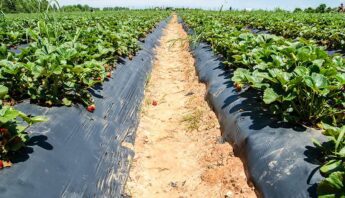For Immediate Release: October 17, 2019
On heels of chlorpyrifos ban, public health and farmworker advocates call for restrictions on widely-used drift-prone fumigant
Sacramento: Dozens of residents from across the state converged on the capital today to weigh in on new restrictions under discussion for the pesticide 1,3-dichloropropene (1,3-D, or Telone), a heavily used and highly drift-prone carcinogenic pesticide. Under an unorthodox agreement in place since 1995, Telone’s manufacturer Dow Agrosciences, now rebranded as Corteva, had inordinate influence over rules for its use, and was tasked with monitoring compliance. That arrangement is now facing fresh scrutiny as the California Department of Pesticide Regulation (DPR) embarks on regular rulemaking after a court judgment found DPR guilty of unlawfully handing over its regulatory authority to Dow.
At a hearing convened by DPR Thursday, residents of California’s farmworking communities lined up to plead for relief from a chemical thats use has risen dramatically over the past two decades, and is now the third most heavily used pesticide in California, at more than 12 million pounds per year.
One by one, more than two dozen residents called on DPR to immediately order all Telone applications to be covered by specialized TIF tarps in order to significantly reduce emissions, and to move swiftly to implement other rigorous and health-protective new restrictions including requiring large buffer zones around treated fields, reducing allowable use rates and limiting the size of individual applications. Currently, applications on the Central Coast’s strawberry fields are routinely tarped, while those in the San Joaquin Valley are not, resulting in some alarmingly high air levels at DPR’s air monitors in the San Joaquin Valley. In 2018, the highest levels ever recorded were measured in Shafter (50ppb) and Parlier (111ppb). After a level of 30 ppb was measured in the air in Merced in 1990, the chemical was banned for five years.
Nearly two years has passed since unprecedented levels were measured in Shafter and a year after the even-higher levels in Parlier, yet to date the state has taken no new action to reduce exposure or emissions in these or any other communities. Telone has been banned for agricultural use in the European Union since 2011.
For concerned residents of the San Joaquin Valley, showing up for the hearing was a necessity. “I took the day off work and got up at 3am to travel from Kern County to this hearing, because I’m scared for my family. Here in Shafter, I’ve seen far too many people suffering and dying of cancer, and I really question whether the decision makers in Sacramento understand what we live with,” said Shafter resident Anabel Márquez. More than 1.6 million pounds of Telone are used each year in Kern County.
There is a long history of puzzling deference by DPR toward Dow when it comes to management of Telone. After the chemical was banned in 1990, it was reintroduced in 1995 under rules created and enforced by Dow, with an annual use cap per 6 by 6 mile township, intended to keep exposure from exceeding the limit of 0.14ppb established by DPR for lifetime average cancer risk level.
The use cap was soon weakened, however. A new rule allowed growers to roll over their unused allocations from prior years, a practice known as banking, and to apply for a waiver from the use cap when they wanted to use even more. The waivers were almost invariably granted. Under intense pressure from public health advocates, DPR ended both banking and waivers, but at the same time revised their method for calculating cancer risk in a manner that allowed them to increase the lifetime average 4-fold, and to increase the annual use cap by 50%, from 90,250 to 136,000 pounds per year per township
In 2018, a superior court judge in Alameda County found that DPR had ceded their regulatory authority to the manufacturer, propelling DPR to begin regular rulemaking. The new rule is expected to be finalized in the summer of 2020.
“It’s hard to think of a clearer case of putting the fox in charge of the henhouse,” said Sarah Aird, co-director of the statewide coalition Californians for Pesticide Reform. “The arrangement DPR made with Dow – letting them make up their own rules, monitor their own compliance, then ignore the rules when it suited them – almost defies belief. Luckily, a court agreed with us. We trust that under the Newsom Administration, DPR will now start to prioritize the health of communities over corporate profits.”
This is Dow/Corteva’s second time in the spotlight in California in as many weeks, after the announcement last week that use of their brain-damaging organophosphate pesticide chlorpyrifos will be forbidden after December 31, 2020. California’s action followed the decision by the Trump Administration to reverse a planned federal ban, just two months after Dow made a $1 million contribution to Trump’s inauguration committee. After a torrent of bad publicity, Dow Agrosciences rebranded itself as Corteva.
Contacts:
Anne Katten, 916-204-2876, akatten@crlaf.org
Jane Sellen, 530-575-0332, jane@pesticidereform.org
##################################
Californians for Pesticide Reform is a diverse, statewide coalition of over 190 member groups working to strengthen pesticide policies in California to protect public health and the environment. Member groups include public and children’s health advocates, clean air and water groups, health practitioners, environmental justice groups, labor, education, farmers and sustainable agriculture advocates from across the state.







